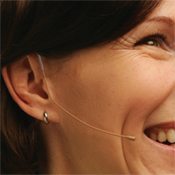 Earset, headworn, and over-the-ear microphones are quickly taking the place of lavalier and handheld microphones in many houses of worship. As with all microphones, choosing the right one for your application is important, so here I will discuss a few of the deciding factors all churches should consider, and I’ll make some recommendations on specific models.
Earset, headworn, and over-the-ear microphones are quickly taking the place of lavalier and handheld microphones in many houses of worship. As with all microphones, choosing the right one for your application is important, so here I will discuss a few of the deciding factors all churches should consider, and I’ll make some recommendations on specific models.
Why choose an over-the-ear microphone in the first place? Since the diaphragms of most earset mics are mini-me sized, they won’t have the strong robust sound that a handheld or larger lavalier microphone has. But don’t let their small size fool you – they can still provide very rich and professional performance. One of the most appealing benefits of an earset mic is that it stays in one place when worn properly, so regardless of whether the user moves his or her head, the mic stays at the same location. This can be a sound tech’s favorite feature because he/she doesn’t have to constantly ride the fader or use a less-than-desirable compressor / expander setting on a dynamics processor to overcome the physical and mechanical moves that can occur, particularly with a more animated speaker or singer.
Here are a few points to consider when choosing an earset microphone:
1. |
What will the mic be used for? If the mic is for speech only, then its frequency response isn’t as much of a concern, so you have many options. Offering defined clarity at a very affordable price, the OSP Audio HS-09 is one of my favorites for liturgy. If the mic needs to also handle the task of singing vocals, then that narrows the field a bit. You will need a mic with a high-quality capsule that can handle the added SPL, like the Sennheiser HSP4 or the DPA 4066, both of which are available in reduced-sensitivity versions for very loud vocals (be sure to specify your preference when ordering the mic). |
2. |
Wired or Wireless?This might seem odd at first, but not all headworn mics require a wireless setup. For example, you might have a singing drummer, or the drummer might be the band leader and will need to communicate over a monitor system to the rest of the worship team. Since his/her hands are occupied, a headworn mic is a good choice, but he/she won’t benefit from the freedom of movement that a wireless system would provide. So why not save some $ and go wired?
The same would apply for any team member who doesn’t necessarily need to move around. Almost any headworn or over-the-ear mic can be terminated for wired or wireless use – you just need to specify “XLR termination” when you order. On that note, a handy problem-solver that should be in every sound tech’s toolbox is the Provider Series PPA (Phantom Power Adaptor). The PPA allows you to transform any lavalier or headworn microphone that’s been configured for Shure, Sennheiser or Audio-Technica wireless systems into a hardwired microphone. This inexpensive accessory can be a performance-saver if you can’t find a clear frequency, run out of spare batteries, or if your wireless system fails at exactly the wrong time. |
3. |
Live or Broadcast?If you’re preaching or performing live on stage with a headworn microphone, consider your proximity to nearby loudspeakers and stage monitors. You’ll usually get a fuller, richer sound from omnidirectional mics, but they are more prone to feedback. To avoid this, choose an earset mic with a directional pickup pattern – most manufacturers offer both omni and cardioid versions of their earsets.
If you’re streaming video of your services or producing DVDs, the miniature size of over-the-ear mics can be very appealing, particularly for close-up shots on the pastor’s / speaker’s face. Many earset mics are very stealthy in their appearance and come in different flesh tones for a variety of skin colors. Some manufacturers even make short-boom versions – the Countryman E2 and Audio-Technica BP893 are examples. These mics are nearly invisible on camera and are easily hidden in makeup. |
4. |
Form and Fit.You may have noticed that not everyone’s ears are the same size and shape! Furthermore, the way the microphone attaches to the head is different between brands and models. Many, like the Countryman E6, have a traditional single ear design; one single-ear mic I really like is the Audio-Technica BP892, because its boom hangs under the ear for a very natural feel. Other microphones employ a two-ear design and tend to stay in place better for the more active user. If you’re not sure which type would better suit your application, look for a single-ear mic with a dual-ear accessory clip, like the Point Source R-DMC, which will give you the flexibility of both.
An obvious (but often overlooked) consideration is if the user will LIKE the feel of a headworn mic. Some of our pastor customers wouldn’t be caught dead wearing one. We’ve heard comments like “I’m not wearing a Britney Spears microphone!” If your pastor is on the fence, you can easily turn an old lavalier mic into a headworn mic with the Provider Series Head Clip to give him / her a test drive. |
5. |
Durability.Not all over-the-ear mics are created to withstand the rigors of constant use. Although you’ll get good, lasting performance from most of them, some are known for their fragility due to very small size and cable diameters.
Make sure that if the user has a heavy-handed tendency with the mic that you choose a robust tool for the job, like the Point Source CO-7 which boasts an “unbreakable boom”. Many earset mics have replaceable cables, windscreens and cable clips, so it’s always a good idea to order spares. Countryman even offers a 2mm diameter “Duramax” cable for all of their E6 series mics. And please, discourage your users from winding the cable around the bodypack for storage – always unplug the microphone, gently coil the cable and place it back in its case. |
6. |
Special Features. Some earset mics are now available with an integrated earbud that allows the user to hear whatever you send back to them for monitoring. Da-Cappo’s DA15 is one example, and Countryman offers an accessory cable for their E2 and E6 earsets that will attach to a single Shure SE425 or SE535 earphone (with a dual earphone version coming later this year). As wireless in-ear monitoring continues to gain favor, I expect this configuration to become more common. |
I hope this helps you in the decision process – if you have any questions, feel free to post a comment below or email me at jmcleod@churchaudiovideo.com. And remember, once you have made your selection, be sure to follow the specific instructions given by the manufacturer for proper wear and care.

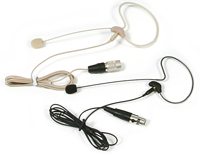
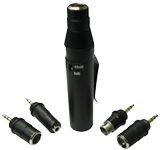
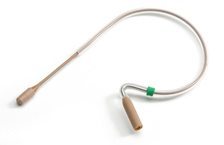

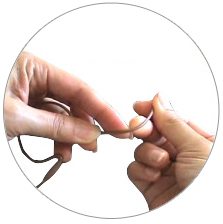
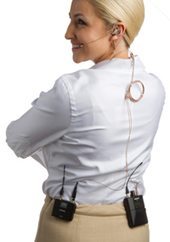
We tried several different models of earset microphones but we were never satisfied. Our pastor tried his best to get accustomed to the microphone, but the biggest problem was that he occasionally removes his glasses during a sermon. When he put them back on, he would dislodge the microphone. This was even more of a problem with the lighter microphones because he could not even feel it on his ear so he was not aware when he repositioned it or knocked it off.
Thanks so much for your comment. Yes, that’s a common problem for speakers who wear glasses. Sometimes, an OTE microphone is not the best solution, but if you were to try the Que Audio (formerly Da Cappo) DA12, you might find that it is more robust and will usually stay in place, even for glasses wearers. The other option, obviously, is to use an OTE with dual ear support rather than a single ear.
We have a DPA 4088 headband mic for our pastor, but sadly we rarely use it because of all the hassles we’ve had with it. We often get loud rubbing noises, which I think comes from the headband rubbing against the pastor’s neck, and we also find the mic so sensitive that we can even hear the pastor’s footsteps coming through! We’ve tried many different techniques… adjusting headband; clipping cable onto shirt collar; adjusting transmitter sensitivity, etc. but we can never get consistently good sound.
HI JEFF. i just bought a vocal procesor and a head set mic will be well come .i have a loud voice . Sometimes i sing cospel ,sometimes i sing clasic i play the keyboard and guitar also. what kind of mic do you recomand me? I’LL PREFFER SAMETHING GOOD.Country e2 ? i’d like to be weared. thank you very much, and GOD BLESS YOU
Isac, thanks for checking in. Wired or Wireless? I really like
Que Audio DA12-BE
OSP HS-09
Shure MX 153
Hi Jeff, this was helpful. Thank you! We currently have a Shure wireless pack that goes to a lapel. I’m unfamiliar with this, but could we buy the HS-09 and plug it into the Shure pack? Are all those going to be universal or do they have different connections?
Jeff I really don’t know where to begin but have been praying the holy spirit lead me to the right place and here I am. Our Church the First Heavy Metal Church of Christ is exploding and saving souls and bringing more and more people into church. You can verify the church is legit and check out live feed even. My pastor desperately needs a new quality wireless microphone to preach the word as we have standing room only every Sunday. I am disabled Marine Vet and would be honored to give him this gift but as a new Church trying to get a new building they can’t afford one. I would gladly pay for one myself but I barely make it on disability but do tithe and trust and believe that all things are possible through Christ who strengthens us. I know you are in a business and have to make a profit but I’m praying and asking you to please find it in your heart to donate a head set to our church it doesn’t have to be the best of the best just a good quality witless mic so that those also watching live feed care hear the message. My pastors name is Brian Smith I am not trying to pull any scam just asking ffor help. I would be honored to get it front of the church and to give this to him saying what tour company did in the name of Jesus. If you can’t help can you please direct me to someone who might. I thank you for your time and any consideration you give this. May God continue to bless your business and I will continue to pray and hope to hear back from you. Our church is located in Dayton Ohio and I can’t emphasize what a blessing thisb would be and how many more lives can be brought to know Jesus as there personal savior having everlasting life! You have my email and my phone number is 927 679 6655. I pray to hear back from you. God Bless you and your family!
Great delivery. Outstanding arguments. Keep up the
amazing effort.
This page has really helped but I’d like to know which wireless system would go with the Shure MX153. Thank you.
Jedadiah, thanks for you comment. There are numerous wireless systems that will work nicely with the MX153. The Shure BLX or SLX would be the most affordable professional solutions. You can send me a direct email to get your discounted pricing if you’re interested. jmcleod@churchaudiovideo.com. Blessings!
we have new ear set microphones in our large traditional sanctuary. the old one worked okay for me, but our sound system needed to be replaced, so we got the new sets. this last Sunday I felt that the sound was not quite right when I first started speaking. I adjusted and felt like I had a better sound for a little while, but then the distorted, echo-y sound came back. I am very frustrated by this, as people said they had difficulty hearing me, and the mic should stay in one place once it is on. I had to adjust it a little, but it was never that far away from my mouth.
Hi Jeff, just coming across this blog and it’s great! I’m in the hunt for a new headworn mic since I left my countryman e6 behind at my fathers church for a new assignment. The countryman was “OK” but sometimes had fit issues as I have small ears, wear glasses, and preach a little boisterously and sweat which sometimes caused it to slip. I have a new Shurre blx system with a MX153 and I could never get it to fit right (plus it’s beige and I’m AA) so I’ve resorted to an older Shure headset that’s more for aerobics instructors. I’m really interested in the AT BP892, that hooks around the back and sends the mic under rather than over the ear. Looks like it would cling well and adjust to my ear. Thoughts? Any other suggestions?
Todd, so sorry for the very late reply. We’ve been so busy doing installs that I haven’t spent much time on our blogsite. The AT BP892 is a great solution. You’ve correctly noted that since it hangs on to your ear it’s not as easily moved around. Sometimes, using a dual ear solution is better because if you hoop and holler like a lot of Black Preachers do, you can do so with more confidence you’ll not have a “technology malfunction!” If you’d like to email me directly, I can provide some pricing and options if you still need them. jmcleod@churchaudiovideo.com
Hi I’m only 15 but I do my best to do anything that uses technology for my church as no one else can use it as effectively (I made the church website which was a bit of an experience maybe you could give some feedback on it 🙂 http://www.consettgospelhall.org/) I was wondering if you could help me find a very good OTE microphone which does not cost too much as the church does not have the money too pay out on technology like this so I would probably have to use my own money I got for Christmas. It would be great to have one that feels comfortable almost as if it isn’t on your ear and picks up the voice when speaking and singing effectively but doesn’t have interference and doesn’t get the horrible plosive sound with p and t. It would be great for it to be wireless and also if it is easy to set up then that would be better because just to remind you I’m only 15 so I don’t know how to do all the technical software some microphones may require, thank you I hope you can help.
Nathaniel, I really appreciate your asking for help. That said, if your Church can’t afford the technology or if they don’t see the need I think it’s unwise for you to spend your Christmas money on something that only you agree is needed. To do everything you’re requesting would cost at least $500. I wish I could be more help.
We have a female pastor who is soft spoken in her delivery of the liturgy. Her speech pattern is that she starts off in a middle volume range but as she gets to the end of her point she gets much softer, making it difficult to hear her. The volume can not be pushed any more without issues. We currently use a lapel mic but are looking for an over the ear, hoping that it will address the issue. Is there one that you would recommend for this scenario?
IHi Jeff, am looking for a new mic, had the Countrym E6 for my sure wireless and it has gone bad and I don’t want to spend that much again but if I have to then so be it.. I like the size too. Found a pyle earset for a temporary replacement, the only problem with it is it is too long and sticks out. I emcee for non profit events and often allow others to use my mic so I am looking for one that will be fore my ears only, I do like the CO-8WS Waterproof Earworn Microphone but have found no reviews on it. I definitely want something like the countryman, what would you recommend? Do you know anything about the
U-VOICE UVS-70D-SH4 Earhook Headset Mic with Detachable Cable for Shure Wireless Microphone System? Thanks
Hi Jeff, Thanks for your insight. It helped me to choose a Da-cappa which arrives today, Since I have never used one I see no value in a earset with i in ear monitor for public speaking, do you?
Can I please get a quotation for one please?
And where can I buy one and how much it cost?
Thank you